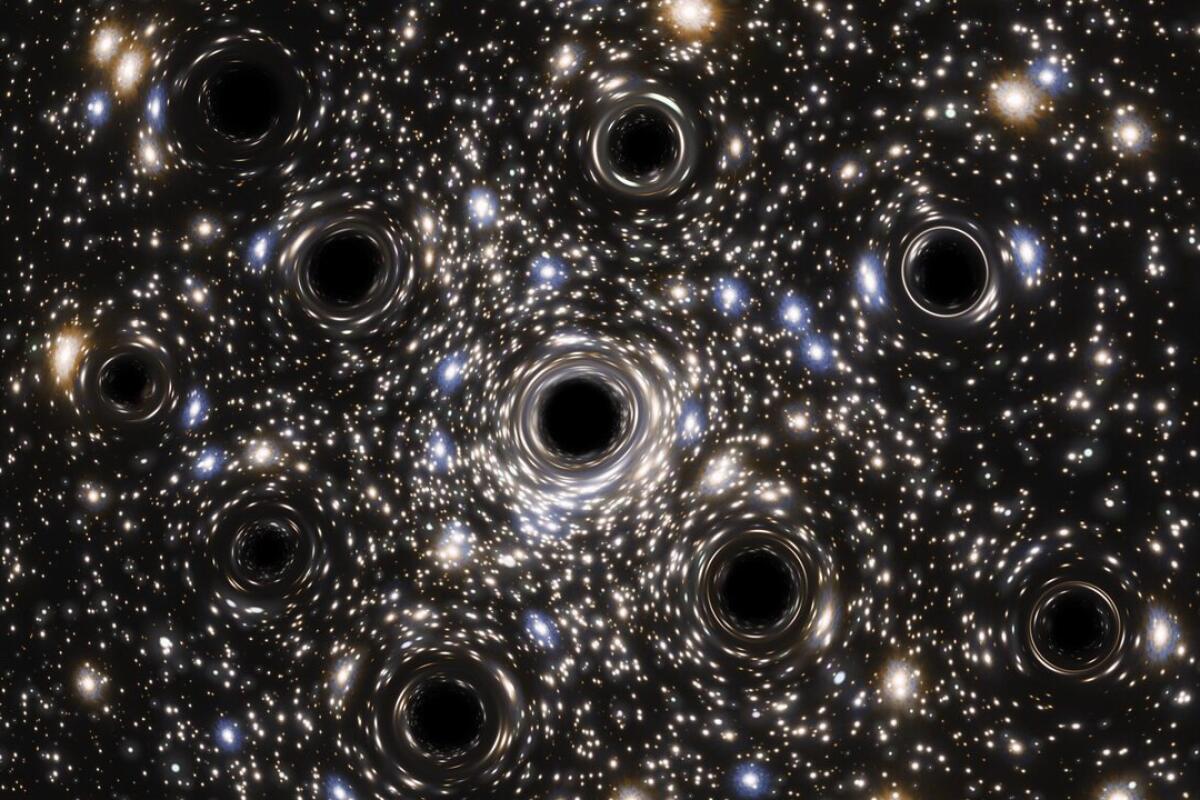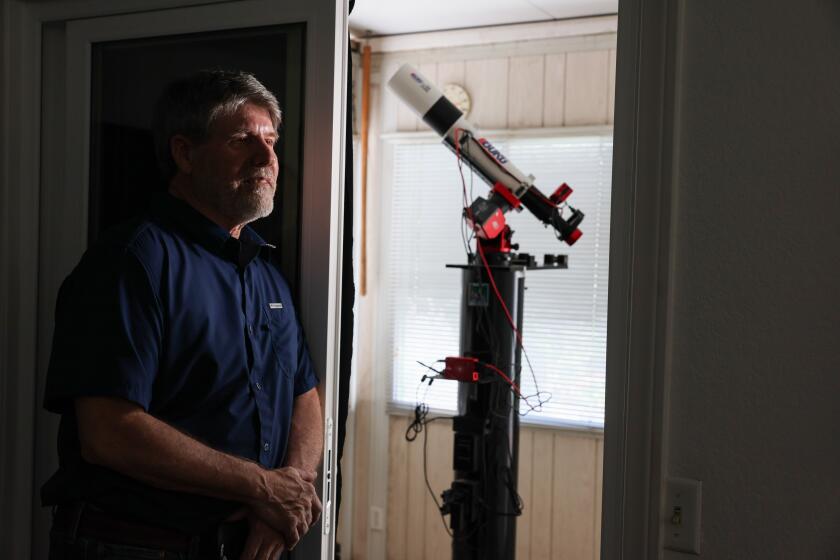Are tiny black holes zipping through our solar system? Scientists hope to find out

- Share via
A mind-bending hypothesis is gaining traction among scientists: The universe may be teeming with microscopic black holes the size of an atom, but with the mass of a city-sized asteroid.
Created just a split second after the Big Bang, these hypothetical black holes would whip quietly through the solar system roughly once every few years, traveling over a hundred times faster than a bullet.
Some have even argued that an immense explosion that flattened a Siberian forest in 1908 could have been the result of one of these micro black holes impacting Earth.
Now, researchers say they’ve figured out a way to test whether these cosmic bullets truly exist.
With a rare star explosion expected any day now, astrophysicists are relying on a community of hobbyists with backyard telescopes to tell them when it erupts.
In a study published Tuesday in the journal Physical Review D, physicists at MIT say the presence of a tiny black hole speeding through the solar system could be identified by the gentle gravitational nudge it exerted on the Earth and other planets, which would alter their orbital paths by no more than a few feet.
The possibility of proving the existence of micro black holes is generating excitement among some astrophysicists because it could help them to explain a mystery that has taunted them for almost a century: the nature and composition of dark matter.
In the 1930s, astronomers started noticing anomalies in the way galaxies were moving. Lurking in the dark and empty expanse of intergalactic space, something was generating tremendous amounts of gravity to tug on the galaxies — yet it seemingly refused to interact with light or any other force.
Scientists found this mysterious gravitational tugging everywhere. In order to account for it, they hypothesized that it was being caused by invisible mass, or dark matter, that made up roughly 85% of all matter in the universe.
Some physicists have suggested dark matter may be made up of exotic undiscovered particles. Others, such as the MIT researchers, think dark matter probably is just regular matter that is extremely hard to detect. And black holes, the researchers say, are a prime example of the properties of dark matter.
“It’s just fantastic that the most conceptually conservative response is to say, ‘It’s just super tiny black holes that were made a split second after the Big Bang,’” said David Kaiser, a physics professor at MIT and an author on the study.
“It’s not inventing new forms of matter that have not yet been detected. It’s not changing the laws of gravity,” he said.
Still, black holes are not the sole potential culprit and there remains a lot of debate in the field.
Physicists have, in their quest to find dark matter, searched for new exotic particles, as well as regular matter that may have been overlooked — such as black holes of varying sizes. So far, they have come up empty-handed.
Until now, astronomers have been unsure how to search for black holes of a particularly pesky size — those that are too small for their gravity to bend star light.
The MIT researchers determined, through modeling, that these tiny black holes may have formed from pockets of dense matter that collapsed on themselves immediately following the Big Bang.
The researchers simulated what might happen if one of these primordial black holes made a flyby within the orbit of Jupiter. They found that the orbits of Earth, Mars, Venus and Mercury could veer off their original course by up to 3 feet over a decade.
The researchers said they would expect to detect a black hole nudge somewhere between once a year to once every century — depending on the abundance and masses of the black holes.
To put their own minds at ease, the researchers also calculated the likelihood that one of these tiny black holes would strike Earth and found it would only happen roughly once in a billion years.
Even then, the black hole wouldn’t lead to an apocalypse.
Instead, it would pass straight through the Earth, leaving the planet relatively unbothered.
Scientists in the 1970s even showed that a black hole impact would look strikingly similar to an streaking light and explosion over Russia 116 years ago that scientists believe was caused by a small asteroid or comet. (Although, a black hole would also leave an “exit wound.”)
Physics researchers discovered that the mechanics for good skateboarding technique can be surprisingly simple. At least, on paper.
Detecting the existence of mini black holes will require extremely precise measurements of where planets are and models of where they’re supposed to be. Fortunately, scientists have the tools to accomplish this.
NASA’s Jet Propulsion Laboratory in La Cañada Flintridge, for example, has created a detailed model of the solar system that uses Albert Einstein’s general relativity theory of gravity to calculate the expected orbits of the planets and account for hundreds of asteroids in excruciating detail. (They even calculated how the Earth’s ocean tides affect the moon’s orbit.)
NASA scientists also have developed an extremely precise means of determining the distance between the Earth and Mars. By measuring the time it takes radio signals to travel from Earth to spacecraft orbiting Mars, or to rovers on its surface, scientists can calculate the red planet’s distance from Earth within two feet.
“It’s really only a few decades where we’ve had that level of accuracy,” Kaiser said. “From a series of space program missions, we can worry about if Mars is 50 centimeters off from where we expect it to be.”
To convince the skeptics, the scientists also would have to show that the nudge wasn’t caused by a passing asteroid.
The researchers say that the speed of the black holes — which would be traveling more than two times faster than anything else in our solar system — would create an unmistakably unique wobble in the planets’ orbits.
And astronomers are pretty good at spotting objects with a mass similar to that of the hypothetical black holes. In 2017, researchers identified the first object from another star to enter our solar system, which had far less mass than a microscopic black hole would.
Whether or not they detect a passing black hole, the scientists say it will push forward humanity’s understanding of dark matter.
“Of course I’d love to discover dark matter in the solar system,” said Benjamin Lehmann, a postdoctoral student at MIT and an author of the study. However, “if this kind of observation is what helps us to close this window and say dark matter is not in the form of these primordial black holes, that’s really important information.”
By proposing a method for simply testing this possibility, “they’ve done ... exactly what we should be doing in dark matter searches,” said Vera Gluscevic, a cosmology professor at USC who was not involved with the study. “We should not leave any stone unturned.”
Although the scientists plan to keep refining planetary motion models and dig through historical observations from the last few decades for signs of the black holes, the main test will be to simply watch and wait.








